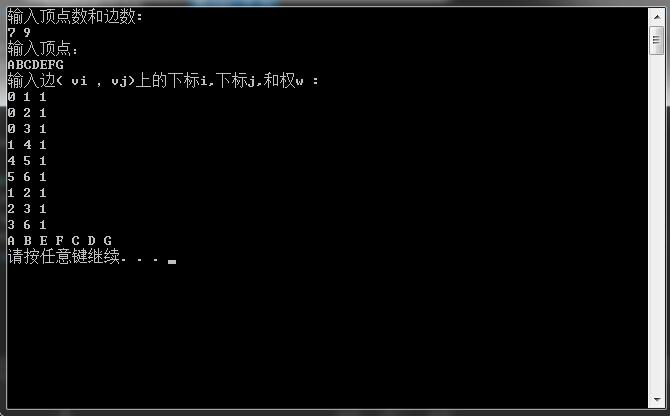拓扑排序
在一个产品生成过程中,必须完成前一道的工序,才能进入下一道工序加工。像这样的工程我们可以用有向图来表示。
在一个表示工程的有向图中,用顶点表示活动,用弧表示活动之间的优先关系,这样的有向图为顶点表示活动的网,我们称为AOV 网( Activity On VertexNetwork )。

图1图 1
那什么又是拓扑排序呢?
设G=(V,E) G = ( V , E ) 是一个具有n n 个顶点的有向图,V V 中的顶点序列v1,v2,...,vn v 1 , v 2 , . . . , v n ,满足若从顶点vi v i 到vj v j ,有一条路径, 则在顶点序列中顶点vi v i ,必在顶点vj v j 之前。则我们称这样的顶点序列为一个拓扑序列。
对AOV 网进行拓扑排序的基本思路是: 从AOV 网中选择一个入度为0 的顶点输出,然后删去此顶点,井删除以此顶点为尾的弧,继续重复此步骤,直到输出全部顶点或者AOV 网中不存在入度为0 的顶点为止。相关代码如下:
#include<vector>
#define INFINITY 65535
using namespace std;
struct EdgeNode//边表结点
{
int adjvex;//顶点下标
int weight;//权值
EdgeNode *next;//下一个结点
};
struct VertexNode//顶点表结点
{
char vert;//顶点信息
int in=0;//入度
EdgeNode* firstedge;//边表头指针
};
class GraphAdjList
{
public:
GraphAdjList();
~GraphAdjList();
void CreateALGraph();//构建网图
void BFSTraverse();//广度历遍算法
bool TopologicalSort();//拓扑排序
private:
vector<VertexNode> adjList;
vector<bool> visited;//访问标志数组
int numVertexes, numEdges;//顶点数、边数
};
#include "GraphAdjList.h"
#include<iostream>
#include<queue>
#include<stack>
using namespace std;
GraphAdjList::GraphAdjList()
{
}
GraphAdjList::~GraphAdjList()
{
}
void GraphAdjList::CreateALGraph()//构建网图
{
int i, j, w;
cout << "输入顶点数和边数:" << endl;
cin >> numVertexes >> numEdges;
cout << "输入顶点:" << endl;
VertexNode vert;
for (int k = 0; k < numVertexes; k++)
{
cin >> vert.vert;
vert.firstedge = NULL;
adjList.push_back(vert);
}
cout << "输入边( vi ,vj)上的下标i,下标j,和权w :" << endl;
for (int k = 0; k < numEdges; k++)
{
cin >> i >> j >> w;
EdgeNode *p = new EdgeNode;
p->adjvex = j;
p->weight = w;
p->next = adjList[i].firstedge;
adjList[i].firstedge = p;
adjList[j].in++;
}
}
void GraphAdjList::BFSTraverse()//广度历遍算法
{
for (int i = 0; i < numVertexes; i++)
visited.push_back(false);
queue<int> Q;
EdgeNode* p;
for (int i = 0; i < numVertexes; i++)
{
if (!visited[i])
{
visited[i] = true;
cout << adjList[i].vert << " ";
Q.push(i);
while (!Q.empty())
{
i = Q.front();
Q.pop();
p = adjList[i].firstedge;
while (p)
{
if (!visited[p->adjvex])
{
visited[p->adjvex] = true;
cout << adjList[p->adjvex].vert << " ";
Q.push(p->adjvex);
}
p = p->next;
}
}
}
}
cout << endl;
}
bool GraphAdjList::TopologicalSort()//拓扑排序
{
stack<int>stack;
EdgeNode* e;
int count = 0,gettop;
for (int i = 0; i < numVertexes; i++)
{
if (0 == adjList[i].in)
stack.push(i);
}
while (stack.size())
{
gettop = stack.top();
stack.pop();
cout << adjList[gettop].vert << "";
count++;
for (e = adjList[gettop].firstedge; e; e = e->next)
{
if (!(--adjList[e->adjvex].in))
stack.push(e->adjvex);
}
}
cout << endl;
if (count < numVertexes)
return true;
else
return false;
}
测试主程序:
#include <iostream>
#include "GraphAdjList.h"
using namespace std;
int main()
{
GraphAdjList G;
G.CreateALGraph();
G.TopologicalSort();
system("pause");
return 0;
}
输入图1中的AOV网,在VS上运行结果如下:

版权声明:本文不是「本站」原创文章,版权归原作者所有 | 原文地址: